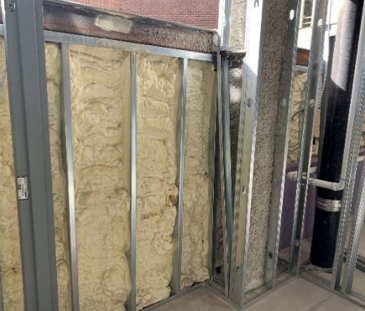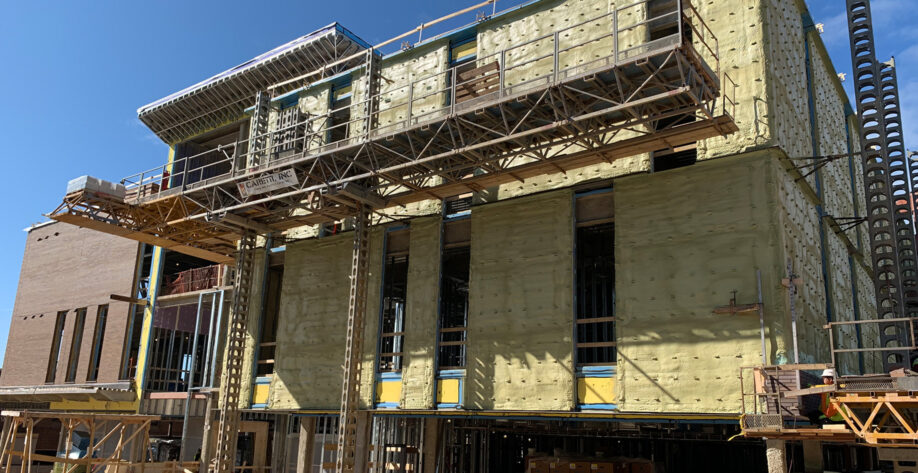Spray polyurethane foam is generally used in the interior wall cavity and exterior building walls for its insulating value and as an air/vapor barrier. Is it better to use open or closed cell polyurethane foam insulation in the building enclosure? The answer varies depending on your geographical location and intended use. The following outlines the characteristics, advantages, and disadvantages of each product.
Open Cell Foam Insulation

- Cell structure: small expansive structure with broken cell walls
- Density: .5-.6 pounds per cubic foot
- Permeability: 15 perms at 2” inch depth
- R value/ inch: approx. 3.5-3.8
- Expansion rate: up to 100 times its size
- Texture: soft and airy
- Maximum installed thickness per layer (pass): 5-8 inches
- Good soundproofing
- Affordable compared to closed
- Not ideal for extreme weather
Closed Cell Foam Insulation

- Cell structure: fully enclosed independent cell walls
- Density: 1.7-2 pounds per cubic foot
- Permeability: less than 1 perm at 2” inch depth
- R value/ inch: approx. 6-7
- Expansion rate: up to 25 times its size
- Texture: rigid and firm
- Maximum installed thickness per layer (pass): 1½ – 2 inches depending on product utilized
- Vapor barrier
- R-value at open cell
Open Cell Foam Insulation
Advantages: Open cell foam insulation is much more affordable to use than closed cell foam due to its increased expandability. This feature makes it ideal for large openings, such as stud walls and larger wall cavities. The weight of the material is 3 to 4 times less per cubic foot than that of closed cell products. It also has sound dampening capabilities due to the open cell structure’s ability to trap sound waves.
Disadvantages: Open cell foam is a combustible material. There is a possibility of exothermic (heat) reaction when it is sprayed thicker than the recommended thickness per pass. This can result in material cell damage or self-combustion. Open cell foam insulation has a lower R value per inch. It should not be used in below-grade or exterior wall cavities due to the potential for moisture absorption. Since the vapor permeability is quite high, it can be susceptible to moisture intrusion and material damage during windblown rain events. It is generally not suitable for extreme temperatures. It is not practical for use in modern buildings with shallow cavity walls. It is also necessary to install AVB membranes.
Closed Cell Foam
Advantages: Closed cell foam provides superior air and moisture protection. It has better R value than open cell foam, which means you need less insulation in cavity walls to provide required R values. It is more suitable for areas with extreme temperatures. Closed cell foam is also cold and water resistant. It provides superior insulation, air, and vapor barrier capabilities.
Disadvantages: Closed cell foam is a combustible material. There is a possibility of exothermic (heat) reaction when sprayed thicker than recommended thickness per pass, which can result in material cell damage or self-combustion or delamination/cohesive failure between lifts. It is expensive compared to open cell and other insulations, such as fiberglass blanket insulation.
Conclusion
When constructing air-tight, high-performance wall assemblies in modern buildings, spray-applied foam insulation is an ideal material to use. It should be noted that there are design considerations that need to be deliberated before using or specifying these materials, such as fire resistance and vapor permeance. For instance, both materials are classified as foam plastic insulation and categorized as combustible. Thus, the material in habitable spaces and in most un-habitable spaces must be covered by a non-combustible surface, such as ½” dry wall or intumescent coatings. Every building condition and type provides for a unique condition or situation. The owner, designer, and contractor need to be aware of the environment and driving forces that lead to the choice of spray polyurethane foams, including the use of building, climate and other mitigating circumstances. When considering the use of these products, consultation with a building enclosure expert is recommended.
Tagged In:
Building Enclosure Design & Consulting
